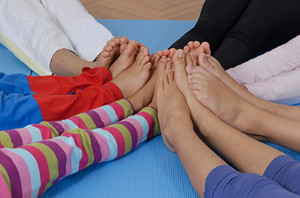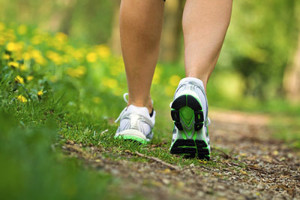
Biomechanics in Podiatry
Podiatry is a branch of medicine that deals with the study, diagnosis, and treatment of foot and ankle conditions. There are various subdivisions in podiatry; biomechanics is one of them. Biomechanics is the way in which the bones, muscles, and joints of the feet and lower limb interact with each other.
Our feet play crucial roles in the way we move, and it is rare to have feet that are completely symmetrical. Common biomechanical issues include high or low arches or uneven leg heights. Excessive pronation often leads to fallen arches, or flat feet, and is a common cause of running injuries. People whose feet are over-pronated tend to have flexible and unstable feet. Pain is usually experienced during walking and running.
At times, people may be able to adapt to these abnormalities without any difficulties, but in other cases, these issues can cause a great deal of pain. This pain occurs because the joints, muscles, ligaments, and tendons are put under an excess amount of stress during movement. Common symptoms of biomechanical problems stemming from the feet include hip pain, knee pain, leg cramps, ankle pain, lower back pain, weak ankles, tripping, heel pain, Achilles pain, and shin splints.
Many biomechanical issues can be treated with orthotics. Orthotics are shoe insoles that are used to help control the way the foot operates. They can provide relief from foot pain, heel pain, and knee pain. Depending on your specific case, you may need to purchase over-the-counter orthotics or custom orthotics to fit your feet. Your podiatrist will be able to prescribe the perfect orthotic for your feet to help you walk around with ease.
Gait is defined as the way we move our bodies from one point to another. This is usually done by either walking or running. Gait analysis is a method used to assess the way we walk or run to highlight biomechanical abnormalities. Gait analyses are a great way to take a detailed look at how you walk and how your foot moves while you walk. An examination of the feet will help your podiatrist understand why you are suffering pain in other parts of your body.
How to Care for Your Child’s Feet
 Children’s feet tend to be way more vulnerable to deformities compared to those of adults. This is because younger bones are softer in comparison, which allows them to easily be affected by abnormal pressures and forces. Certain foot-related conditions that are commonly found in children are out-toeing, low muscle tone, pigeon toes, and warts. It is critical that you are putting your child’s feet into shoes that are suitable and fit them properly. Avoid purchasing shoes that are too long and broad, or too short and narrow for the feet.
Children’s feet tend to be way more vulnerable to deformities compared to those of adults. This is because younger bones are softer in comparison, which allows them to easily be affected by abnormal pressures and forces. Certain foot-related conditions that are commonly found in children are out-toeing, low muscle tone, pigeon toes, and warts. It is critical that you are putting your child’s feet into shoes that are suitable and fit them properly. Avoid purchasing shoes that are too long and broad, or too short and narrow for the feet.
Making sure that your children maintain good foot health is very important as they grow. If you have any questions, contact one of our podiatrists of The Podiatry Center, PC. Our doctors can provide the care you need to keep you pain-free and on your feet.
Keeping Children's Feet Healthy
Having healthy feet during childhood can help prevent medical problems later in life, namely in the back and legs. As children grow, their feet require different types of care. Here are some things to consider...
Although babies do not walk yet, it is still very important to take care of their feet.
Avoid putting tight shoes or socks on his or her feet.
Allow the baby to stretch and kick his or her feet to feel comfortable.
As a toddler, kids are now on the move and begin to develop differently. At this age, toddlers are getting a feel for walking, so don’t be alarmed if your toddler is unsteady or ‘walks funny’.
As your child gets older, it is important to teach them how to take care of their feet.
Show them proper hygiene to prevent infections such as fungus.
Be watchful for any pain or injury.
Have all injuries checked by a doctor as soon as possible.
Comfortable, protective shoes should always be worn, especially at play.
If you have any questions please feel free to contact our office located in Millburn, NJ . We offer the newest diagnostic and treatment technologies for all your foot and ankle needs.
What to Do to Keep Your Child’s Feet Healthy
Being a parent involves caring for your child in every way you can. You make sure they are eating the right food, being nice to others, and staying out of any trouble. However, it is also important that you are watchful of their health, more specifically their foot health. Maintaining good foot health in childhood is important in preventing later conditions in life from happening. As children continue to develop, their feet require different techniques of care. Here are some various ways in which you can help your child’s feet stay healthy.
A baby needs a lot of care and attention overall, but the importance of their feet should never be forgotten. Before a baby turns one, their feet change and develop greatly. It is important that during this time, a mother avoids putting tight socks on their child. She should also encourage movement of their feet so the baby can begin to feel more comfortable using them.
As a baby enters the toddler years of his or her life, they are begin to walk around. When your baby begins to take those first steps, it is crucial that they are wearing protective shoes on their feet. As a mother that is observant of your child’s feet, you may notice changes in them. This is completely normal as the feet are becoming susceptible to the activity of walking. It is normal for a toddler to be a bit unsteady or to “walk funny” at first.
When your child grows out of their toddler years, it is important that you begin to show him or her how to care for their feet on their own. Practice with your child proper hygiene in order to prevent foot fungus or infection. Since children are constantly on the move, it is crucial to be cautious of any accidents or injuries that might occur. If an injury occurs, it is advised that you take your child to be examined by a doctor immediately. Since your child is still growing, particular injuries can shift the way in which a bone or other important part of the foot is developing.
Babies and kids are always changing and growing. Your job as a parent is to make sure they stay healthy and making sure they are properly maintained. This involves proper foot care and making sure the feet stay healthy. Following this guide, your child can live a long and happy life.
Ingrown Toenail Care
An ingrown toenail is a toenail that grows sideways into the nail bed, causing pain and swelling. Ingrown toenails can worsen and cause drainage, turning into a serious infection.
Several factors affect whether a person is at risk from an ingrown toenail. The many causes include being overweight, diabetes, participating in sports, having a fungal infection of the toe, and cutting your nails too short. Ingrown toenails also have a genetic predisposition, causing some people to be more prone to receive the condition than others. Other causes include improperly fitting shoes and shoes that keep the feet damp.
Ingrown toenails can be preventable with certain measures. For starters, allowing your toe nails to grow slightly longer in length will help prevent them from becoming ingrown. If you have already developed an ingrown toenail, soak the affected toe in warm water. This will alleviate the pain and help prevent an infection from forming. Antibiotic soap or Epsom salts may be added to further help the relieving process and avoid infection. Placing cotton beneath the affected area is also suggested, as this may help the toenail grow upwards and not into the nail bed. Swelling and redness can be reduced by resting with your feet elevated.
A podiatrist should be seen if the pain becomes so serious that it prevents you from doing your everyday activities. If a red streak running up your leg appears or if you suspect your infection has spread, contact a podiatrist immediately. Fast treatments can be undertaken to lessen your pain and have you walking comfortably.
An ingrown toenail can be easily treated with a Band-Aid. Simply wrap the affected toe with a Band-Aid to prevent infection and keep the nail from growing out at a painful angle.
In more serious cases, your podiatrist may decide to make a small incision to remove a portion of your toenail. To prevent the nail from growing back, medication will be placed directly into the nail bed. This procedure would be performed under local anesthesia and is a faster method to alleviate discomfort from an ingrown toenail. Post-procedure directions will have you stay off the affected foot for a day. Afterwards, normal activities can be resumed.
How A Marathon Runner Was Able to Compete Without Shoes
 Marathon runner Peter Loong recently told a story about how he forgot his shoes before getting ready to compete. He was able to receive advice from a barefoot runner who gave him several tips and tricks in order to compete without sneakers. In regards to how he performed, Loong said, “I ran (barefooted) behind the group the whole way... At the end point, even I was shocked that I made it.” Nevertheless, it is no secret that barefoot running requires a certain technique. These runners are required to land on their heels first instead of on the balls of their feet, since this method tends to protect against injury. Loong says that he would not recommend any beginner barefoot runner to run a marathon because the technique takes a while to perfect.
Marathon runner Peter Loong recently told a story about how he forgot his shoes before getting ready to compete. He was able to receive advice from a barefoot runner who gave him several tips and tricks in order to compete without sneakers. In regards to how he performed, Loong said, “I ran (barefooted) behind the group the whole way... At the end point, even I was shocked that I made it.” Nevertheless, it is no secret that barefoot running requires a certain technique. These runners are required to land on their heels first instead of on the balls of their feet, since this method tends to protect against injury. Loong says that he would not recommend any beginner barefoot runner to run a marathon because the technique takes a while to perfect.
Barefoot running has its own share of benefits and disadvantages. If you have any concerns about your feet or ankles, contact one of our podiatrists from The Podiatry Center, PC. Our doctors will treat your foot and ankle needs.
Barefoot Running
The Impact of Barefoot Running
- Running without shoes changes the motion of your running, as most running is done by landing on the heel of the feet.
- Running barefoot requires a different way of running; the landing is done on the front part of the feet.
The Advantages of Barefoot Running
- When running and landing on the front feet, the impact on the feet and ankle is reduced; this can reduce stress injuries.
- It strengthens muscles in the feet, ankles and lower legs.
- Balance of the body is improved, and there is a greater sensory input from the feet to the rest of the body.
The Drawbacks of Barefoot Running
- No protection while running, makes it likely that runners will land on sharp objects and scrapes, bruises and cuts on the feet will result.
- Blisters may form.
- Possibility of plantar fascia problems.
- Risk of getting Achilles tendonitis.
So, what can runners do to make barefoot running safe? It’s best to make a slow transition from running shoes to barefoot running. Once the feet begin to adjust, try walking, then jogging and gradually increasing the distance. Minimalist running shoes may also be an option.
If you have any questions please feel free to contact one of our office located in Millburn, NJ . We offer the newest diagnostic and treatment technologies for all your foot and ankle needs.
Barefoot Running
Barefoot running is becoming a more and more popular running trend throughout the running and jogging communities. However, running without shoes also affects the motions of your stride. When barefoot running, choosing to run without shoes is not the only adjustment you will have to make.
Whenever you run normally with shoes, your heel strikes the ground first as you land while you roll over the ball of your foot and push off with the front part and toes. Barefoot runners land on the front part of their feet and not their heels. This shifts the impact from the back to the front of the foot. In order to do this safely and without much injury, runners need to reduce their stride to create softer landings.
One of barefoot running’s biggest advantages is the reduced risk of injury. Landing on the front of your foot with a reduced stride lessens the stress placed on the back of the foot, heels, and ankles. It also works out many muscles in the feet, ankles, and lower legs that you do not normally get to strengthen because of the different motions. Your posture and balance are also improved with barefoot running, as is your sensory input from your feet to the rest of your body. Studies have shown that countries that have large populations of people who do not wear shoes every day are at lower risk for foot and ankle injuries and complications.
However, there is still some skepticism behind barefoot running because of some disadvantages it brings. One of these is the complete lack of protection for your feet while running. Bruises, scrapes, cuts, and even blisters can easily form when you have no protection from sharp or rough objects on the ground. Landing on the front of your feet can also cause Achilles tendonitis because of the overuse of the Achilles tendon.
Despite this, barefoot running can be made safe and enjoyable if you make a slow transition from your normal running routine into barefoot running. Rather than jumping straight into barefoot running, gradually work your way from walking to jogging to running, increasing the distance each time. It is also recommended to start off on flat, even surfaces that do not contain sharp or dangerous objects because your feet are unprotected. Minimalist running shoes are a great middle ground to start with because they combine the protection of shoes with the fit and feel of barefoot running.
The Dangers of Overuse Injuries
 Injuries are a common problem for athletes of all sports. It is important that you take preventative measures so that you can avoid encountering any injuries such as sore knees and sprained ankles. One of the most common causes of injuries for runners is overuse. Overuse injuries are the result of pushing your muscles, tendons, and bones past the limit they are used to. A tip to avoid overuse injuries is to ease your way into a new running routine so that you are not doing too much, too soon. Another helpful tip is to replace your sneakers after every 500 miles of use, since worn-out sneakers make you much more susceptible to injury.
Injuries are a common problem for athletes of all sports. It is important that you take preventative measures so that you can avoid encountering any injuries such as sore knees and sprained ankles. One of the most common causes of injuries for runners is overuse. Overuse injuries are the result of pushing your muscles, tendons, and bones past the limit they are used to. A tip to avoid overuse injuries is to ease your way into a new running routine so that you are not doing too much, too soon. Another helpful tip is to replace your sneakers after every 500 miles of use, since worn-out sneakers make you much more susceptible to injury.
Exercising your feet regularly with the proper foot wear is a great way to prevent injuries. If you have any concerns about your feet, contact one of our podiatrists of The Podiatry Center, PC. Our doctors will treat your foot and ankle needs.
How to Prevent Running Injuries
Many common running injuries are caused by overuse and overtraining. When the back of the kneecap starts wearing out and starts causing pain in your knee, this is commonly referred to as runner’s knee. Runner’s knee is a decrease in strength in your quadriceps and can occur if you’re not wearing properly fitted or supporting shoes. To prevent runner’s knee, focusing on hip strengthening is a good idea, as well as strengthening your quads to keep the kneecaps aligned.
What Are Some Causes of Running Injuries?
- One cause of a common running injury is called iliotibial band syndrome.
- Plantar fasciitis is also another common injury.
- Stress fractures can occur from overtraining, lack of calcium, or even your running style.
Best Ways to Prevent Running Injuries
- Wear footwear that fits properly and suits your running needs.
- Running shoes are the only protective gear that runners have to safeguard them from injury.
- Make a training schedule. Adding strengthening exercises as well as regular stretching can help keep you strong and limber and can lessen the possibility of injuries.
- Stretching keeps muscles limber; this will help you gain better flexibility.
If you have any questions please feel free to contact our office located in Millburn, NJ . We offer the newest diagnostic and treatment technologies for all your foot and ankle needs.
How to Prevent Running Injuries
Overtraining and overusing the feet are the main causes of common running injuries. A number of these common injuries are caused by overrunning. Runner’s knee is a condition that is characterized by the back of the kneecap beginning to wear away and cause pain in the knee. This frequently occurs due to either a decrease in strength in the quadriceps muscles or ill-fitting shoes that are lacking in proper support for the inside of the forefoot. Strengthening exercises focusing on the quad muscle and sports orthotics are the usual treatments for those suffering from runner’s knee. Prevention of the condition lies in a focus on hip strengthening and quad-strengthening to keep the kneecap aligned. To help learn the best exercise to heal runner’s knee, one can also undergo physical therapy.
One common injury, called iliotibial band syndrome, is often caused by overtraining. This condition occurs when the iliotibial band gets irritated, creating pain and discomfort in the outside knee area. Plantar fasciitis, another common running injury, also occurs as a result of inflammation and irritation. Plantar fasciitis is an inflammation and irritation of the bone in the foot. A large amount of pain is often experienced due to plantar fasciitis. The condition can be caused by a high arch, improper footwear, tight muscles, or flat feet. It can best be avoided by stretching and wearing appropriate footwear that supports the foot.
Another common injury for runners is stress fractures. These injuries occur due to running style, overtraining, or a lack of calcium. Stress fractures most often occur in several locations in runners, including the inner bone of the leg, the thighbone, the bone at the base of the spine and the bones of the toes. Stress fractures are best prevented by wearing proper footwear and by running on flat and hard surfaces; this will absorb some of the shock created during running.
Aside from overtraining, other causes of common running injuries include ill-fitting footwear, a lack of flexibility and strength, and irregular biomechanics. The best way to avoid running injuries is to prevent them from even occurring. Both iliotibial band syndrome and stress fractures are preventable. The first step that should be taken to prevent running injuries is to only wear footwear that fits properly and that is appropriate for whatever activity you are doing. Running shoes are the only protective gear available to runners that can safeguard them from sustaining injuries. Choosing the right pair of shoes is therefore extremely important. While running shoes are an important factor, it is also important to consider other facets of your running routine such as training schedules, flexibility, and strengthening. These elements should be considered and altered according to your running needs to best maximize your run and minimize the possibility of injury. Careful stretching before and after a run should also be considered to help prevent running injuries. Stretching muscles enables greater flexibility and a lesser chance of sustaining injury.
Signs You May Have Toenail Fungus
 Toenail fungus usually appears as yellow or white spots on the toenail. A fungus can drastically alter the appearance of a foot by thickening the toenail and making it appear crumbly. Nevertheless, studies have shown that men are far more likely to develop fungus when compared to women. Another factor that plays a role in fungi susceptibility is age. As you grow older, you are more likely to develop a fungus on your feet. Although toenail fungus typically isn’t life threatening, you should want to treat it as soon as possible to help maintain healthy feet. If you have diabetes, it is especially important that you treat the fungus in order to prevent any complications that may occur.
Toenail fungus usually appears as yellow or white spots on the toenail. A fungus can drastically alter the appearance of a foot by thickening the toenail and making it appear crumbly. Nevertheless, studies have shown that men are far more likely to develop fungus when compared to women. Another factor that plays a role in fungi susceptibility is age. As you grow older, you are more likely to develop a fungus on your feet. Although toenail fungus typically isn’t life threatening, you should want to treat it as soon as possible to help maintain healthy feet. If you have diabetes, it is especially important that you treat the fungus in order to prevent any complications that may occur.
For more information about treatment, contact one of our podiatrists of The Podiatry Center, PC. Our doctors can provide the care you need to keep you pain-free and on your feet.
Toenail Fungus Treatment
Toenail fungus is a condition that affects many people and can be especially hard to get rid of. Fortunately, there are several methods to go about treating and avoiding it.
Antifungals & Deterrence
Oral antifungal medicine has been shown to be effective in many cases. It is important to consult with a podiatrist to determine the proper regiment for you, or potentially explore other options.
Applying foot powder on the feet and shoes helps keep the feet free of moisture and sweat.
Sandals or open toed shoes – Wearing these will allow air movement and help keep feet dry. They also expose your feet to light, which fungus cannot tolerate. Socks with moisture wicking material also help as well.
If you have any questions please feel free to contact our office located in Millburn, NJ . We offer the newest diagnostic tools and technology to treat your foot and ankle needs.
Toenail Fungus
Toenail fungus is a frustrating problem that affects many people. It can be persistent and hard to get rid of. As many different types of fungi are present throughout the environment, it is very easy to contract toenail fungus.
The feet are especially susceptible to toenail fungus because shoes and socks create the ideal dark and moist environment that fungal infections thrive in. While fungal infections of the nail plate are quite common, if left untreated they can spread beyond the toenail and into the skin and other parts of the body.
Signs of toenail fungus include a thickened nail that has become yellow or brown in color, a foul smell, and debris beneath the nail. The toe may become painful due to the pressure of a thicker nail or the buildup of debris.
Treatment for toenail fungus is most effective during the early stages of an infection. If there is an accumulation of debris beneath the nail plate, an ingrown nail or a more serious infection can occur. While each treatment varies between patients, your podiatrist may prescribe you oral medications, topical liquids and creams, or laser therapy. To determine the best treatment process for you, be sure to visit your podiatrist at the first signs of toenail fungus.




